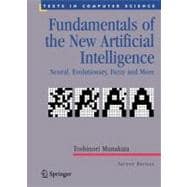
What is included with this book?
| Preface | p. v |
| Introduction | p. 1 |
| An Overview of the Field of Artificial Intelligence | p. 1 |
| An Overview of the Areas Covered in this Book | p. 3 |
| Neural Networks: Fundamentals and the Backpropagation Model | p. 7 |
| What is a Neural Network? | p. 7 |
| A Neuron | p. 7 |
| Basic Idea of the Backpropagation Model | p. 8 |
| Details of the Backpropagation Mode | p. 15 |
| A Cookbook Recipe to Implement the Backpropagation Model | p. 22 |
| Additional Technical Remarks on the Backpropagation Model | p. 24 |
| Simple Perceptrons | p. 28 |
| Applications of the Backpropagation Model | p. 31 |
| General Remarks on Neural Networks | p. 33 |
| Neural Networks: Other Models | p. 37 |
| Prelude | p. 37 |
| Associative Memory | p. 40 |
| Hopfield Networks | p. 41 |
| The Hopfield-Tank Model for Optimization Problems: The Basics | p. 46 |
| One-Dimensional Layout | p. 46 |
| Two-Dimensional Layout | p. 48 |
| The Hopfield-Tank Model for Optimization Problems: Applications | p. 49 |
| The N-Queen Problem | p. 49 |
| A General Guideline to Apply the Hopfield-Tank Model to Optimization Problems | p. 54 |
| Traveling Salesman Problem (TSP) | p. 55 |
| The Kohonen Model | p. 58 |
| Simulated Annealing | p. 63 |
| Boltzmann Machines | p. 69 |
| An Overview | p. 69 |
| Unsupervised Learning by the Boltzmann Machine: The Basics Architecture | p. 70 |
| Unsupervised Learning by the Boltzmann Machine: Algorithms | p. 76 |
| Appendix. Derivation of Delta-Weights | p. 81 |
| Genetic Algorithms and Evolutionary Computing | p. 85 |
| What are Genetic Algorithms and Evolutionary Computing? | p. 85 |
| Fundamentals of Genetic Algorithms | p. 87 |
| A Simple Illustration of Genetic Algorithms | p. 90 |
| A Machine Learning Example: Input-to-Output Mapping | p. 95 |
| A Hard Optimization Example: the Traveling Salesman Problem (TSP) | p. 102 |
| Schemata | p. 108 |
| Changes of Schemata Over Generations | p. 109 |
| Example of Schema Processing | p. 113 |
| Genetic Programming | p. 116 |
| Additional Remarks | p. 118 |
| Fuzzy Systems | p. 121 |
| Introduction | p. 121 |
| Fundamentals of Fuzzy Sets | p. 123 |
| What is a Fuzzy Set? | p. 123 |
| Basic Fuzzy Set Relations | p. 125 |
| Basic Fuzzy Set Operations and Their Properties | p. 126 |
| Operations Unique to Fuzzy Sets | p. 128 |
| Fuzzy Relations | p. 130 |
| Ordinary (Nonfuzzy) Relations | p. 130 |
| Fuzzy Relations Defined on Ordinary Sets | p. 133 |
| Fuzzy Relations Derived from Fuzzy Sets | p. 138 |
| Fuzzy Logic | p. 138 |
| Ordinary Set Theory and Ordinary Logic | p. 138 |
| Fuzzy Logic Fundamentals | p. 139 |
| Fuzzy Control | p. 143 |
| Fuzzy Control Basics | p. 143 |
| Case Study: Controlling Temperature with a Variable Heat Source | p. 150 |
| Extended Fuzzy if-then Rules Tables | p. 152 |
| A Note on Fuzzy Control Expert Systems | p. 155 |
| Hybrid Systems | p. 156 |
| Fundamental Issues | p. 157 |
| Additional Remarks | p. 158 |
| Rough Sets | p. 162 |
| Introduction | p. 162 |
| Review of Ordinary Sets and Relations | p. 165 |
| Information Tables and Attributes | p. 167 |
| Approximation Spaces | p. 170 |
| Knowledge Representation Systems | p. 176 |
| More on the Basics of Rough Sets | p. 180 |
| Additional Remarks | p. 188 |
| Case Study and Comparisons with Other Techniques | p. 191 |
| Rough Sets Applied to the Case Study | p. 192 |
| ID3 Approach and the Case Study | p. 195 |
| Comparisons with Other Techniques | p. 202 |
| Chaos | p. 206 |
| What is Chaos? | p. 206 |
| Representing Dynamical Systems | p. 210 |
| Discrete dynamical systems | p. 210 |
| Continuous dynamical systems | p. 212 |
| State and Phase Spaces | p. 218 |
| Trajectory, Orbit and Flow | p. 218 |
| Cobwebs | p. 221 |
| Equilibrium Solutions and Stability | p. 222 |
| Attractors | p. 227 |
| Fixed-point attractors | p. 228 |
| Periodic attractors | p. 228 |
| Quasi-periodic attractors | p. 230 |
| Chaotic attractors | p. 233 |
| Bifurcations | p. 234 |
| Fractals | p. 238 |
| Applications of Chaos | p. 242 |
| Index | p. 247 |
| Table of Contents provided by Ingram. All Rights Reserved. |
The New copy of this book will include any supplemental materials advertised. Please check the title of the book to determine if it should include any access cards, study guides, lab manuals, CDs, etc.
The Used, Rental and eBook copies of this book are not guaranteed to include any supplemental materials. Typically, only the book itself is included. This is true even if the title states it includes any access cards, study guides, lab manuals, CDs, etc.